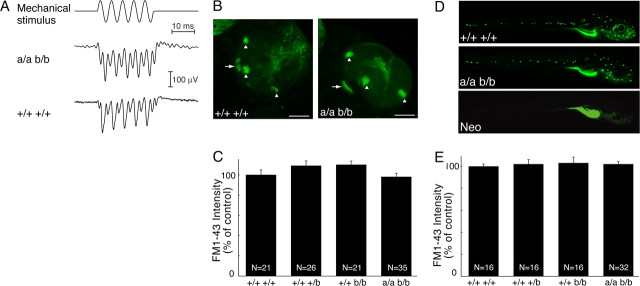Figure 4.
Zebrafish TRPA1 paralogs are not required for inner ear or neuromast mechanosensory hair cell function. A, A stimulus consisting of five cycles of a 200 Hz sinusoidal deflection of ±3 μm (top) excites microphonic responses in larval otocysts. Like the response of a wild-type larva (bottom), a representative microphonic potential from a trpa1a−/−; trpa1b−/− larva (middle) displays oscillations at twice the frequency of stimulation. Each record represents the average response from 500 repetitions of the stimulus. B, FM1-43 labeling of otocystic hair cells of wild-type (left) and trpa1a−/−; trpa1b−/− (right) larvae at 13 dpf. Projections of 40 optical sections through each ear are shown. Arrowheads and arrows indicate cristae and anterior maculae, respectively. Scale bars, 75 μm. C, Relative intensity of FM1-43-labeled otocystic hair cells. N is the number of internal ear sensory patches quantitated. D, FM1-43 labeling of lateral line hair cells of wild-type (top), trpa1a−/−; trpa1b−/− (middle), and neomycin-treated wild-type (bottom) larvae at 7 dpf. E, Quantitation of FM1-43 labeling intensity of lateral line hair cells. The fluorescence intensity of one posterior lateral line (L1) (Ghysen and Dambly-Chaudiere, 2004) and one anterior lateral line (MI1) (Raible and Kruse, 2000) neuromast was quantitated for each larva. N is the total number of neuromasts quantitated. Error bars represent SEM.

